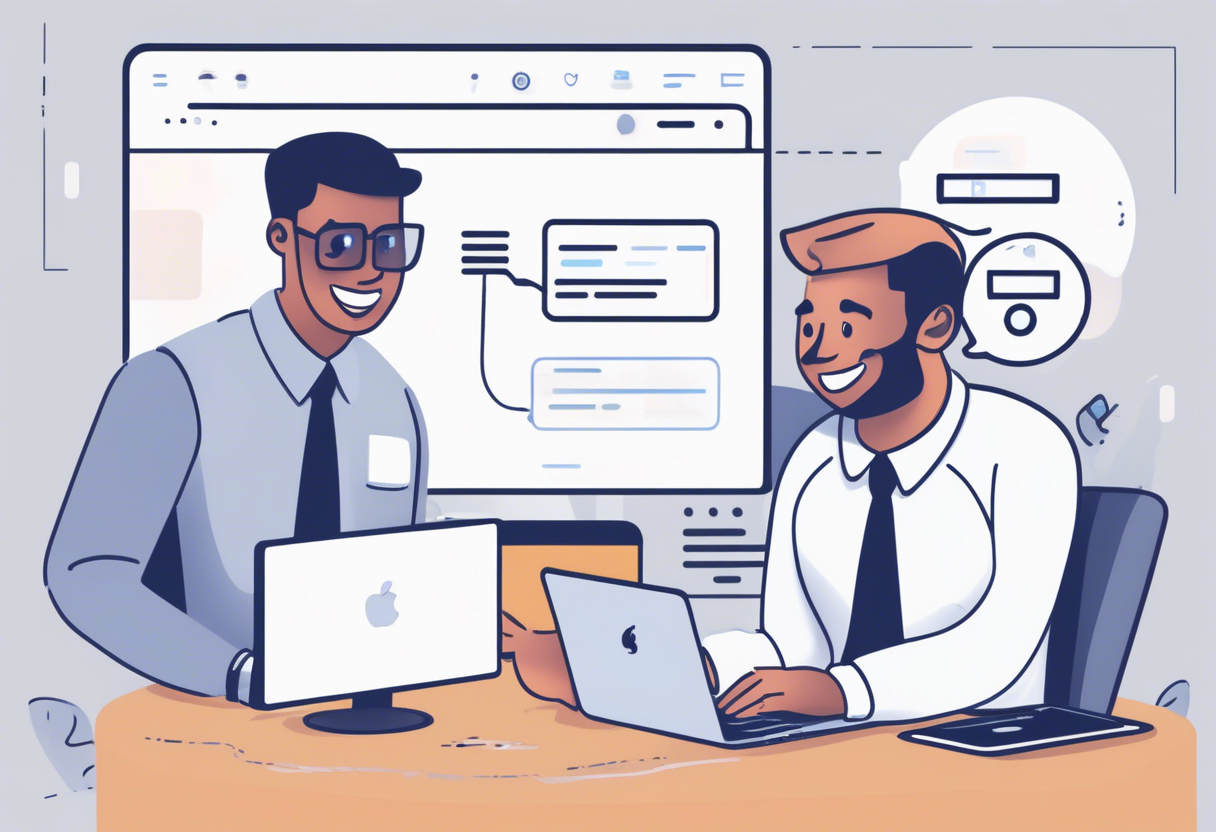
The world of Learning and Development (L&D) is changing fast, with Artificial Intelligence (AI) leading the way. By 2025, AI is expected to drive more than half of all L&D processes. It's not just a future idea—it's happening now, changing how companies train their people. AI brings personalized learning and smart data insights, making training more effective and suited to each person. Think about it: corporate training that adapts to you, driven by data and new ideas. Here, we'll look at how AI is not just improving but transforming L&D, getting us ready for a future where working with AI is crucial. We'll check out its strategic value, real-world uses, and the ethical questions it raises, and see how industries are already benefiting from this tech!
Summary: This article discusses the transformative impact of AI on Learning and Development (L&D), highlighting personalized learning experiences, AI-powered analytics, and the strategic importance of AI in corporate training. It also explores the practical applications, human-AI collaboration, and ethical considerations in creating inclusive AI-driven learning ecosystems.
The Rise of AI in Learning and Development (L&D)
AI's Impact on Personalized Learning in L&D
AI is revolutionizing Learning and Development (L&D) by creating highly personalized learning experiences. By analyzing learner behavior and preferences, AI delivers content tailored to individual needs, enhancing engagement and retention. Tools like Degreed and EdCast exemplify this by designing learning paths aligned with job roles and career aspirations.
AI platforms leverage natural language processing and predictive analytics to identify skill gaps and recommend subsequent learning opportunities. Recognizing the value, 67% of companies plan to increase their AI investment within the next three years. Additionally, AI simplifies the process of measuring the effectiveness of learning programs, linking outcomes to business success.
Importance of AI in Corporate Training Strategies
Incorporating AI into corporate training is essential for maintaining a competitive edge. Personalized learning enhances motivation and productivity by ensuring relevance. Companies utilizing AI can swiftly equip employees with new skills to meet evolving business demands.
AI systems empower employees to tailor their learning journeys, increasing commitment and completion rates. Technologies such as VR and AR provide immersive, hands-on learning experiences without the associated risks and costs. With 86% of CEOs viewing AI as a driver for revenue growth, its significance in workforce development is undeniable. For instance, Walmart's VR simulations for Black Friday training illustrate how AI offers companies a competitive advantage.
Personalized and Customized Learning with AI in L&D
AI-driven Personalization in Learning Paths for Enhanced L&D
AI is revolutionizing education by creating adaptive learning platforms that evolve based on student engagement and performance. These platforms customize lessons to meet each student's unique needs, moving away from the traditional one-size-fits-all approach.
AI can even predict future learning paths, adjusting materials to align with a student's skills and interests. This enhancement is particularly beneficial for distance learning, providing personalized plans accessible on any device. A notable example is Khan Academy's AI tutor, KhanmigoAI, which adapts content based on student performance, offering tailored experiences from early education to college.

Custom AI-driven Content for Learner-Centric Experiences
Personalized learning considers a student's strengths, knowledge, preferences, and learning styles to customize content. This approach allows students to explore various materials while achieving the same learning objectives. By leveraging data such as grades and activities, connected technology extends personalized learning beyond the classroom.
AI platforms provide immediate feedback, enabling teachers to adjust content to better suit each student. In self-paced learning models, students engage with texts or projects that align with their existing knowledge and interests.
Example: AI-powered Adaptive Learning Platforms in L&D
Adaptive learning platforms utilize data on student performance and engagement to deliver customized lessons. They dynamically adjust difficulty and content to optimize learning outcomes. Khan Academy's KhanmigoAI exemplifies this approach, employing AI tutors to personalize education from early childhood through college, integrating life skills with academic content.
Schools implementing these AI-driven platforms report up to a 50% increase in student engagement and significant improvements in performance.
AI-Powered Analytics in L&D
Data-Driven Insights for AI-Enhanced Training
AI learning analytics are revolutionizing training methodologies by leveraging vast amounts of data to uncover patterns in employee learning behaviors. This capability allows for:
- Performance Prediction: Anticipate employee performance and identify individuals who may need additional support.
- Skill Gap Identification: Analyze metrics such as test scores and course completion rates to pinpoint areas where skills are lacking.
- Impact Assessment: Monitor employee interactions with training materials and correlate these with business outcomes like sales and productivity for a clearer view of training effectiveness.
Moreover, AI personalizes the learning experience by adjusting content to match individual learning preferences, thereby enhancing engagement and retention. For example, Nottingham Trent University employs AI to evaluate training program efficacy and detect potential performance issues early, allowing for proactive intervention.
Aligning AI-Driven Training with Business Goals
Integrating AI learning analytics transforms Learning and Development (L&D) from a support function into a strategic partner in achieving business objectives. Key benefits include:
- Resource Optimization: Focus on high-impact training to maximize return on investment.
- Predictive Skill Management: Identify and address future skill gaps before they become problematic.
- Engagement Insights: Utilize AI-driven insights to combat employee disengagement and turnover, linking training efforts to retention strategies.

For instance, Duolingo leverages AI to tailor language learning paths based on user progress, enhancing retention and accelerating skill acquisition, thus supporting business growth.
Real-World AI Applications in Learning Analytics
AI is making significant strides in various sectors by:
- Personalizing Learning: Tailoring educational content to individual needs.
- Offering Adaptive Tests: Providing real-time feedback to improve learning outcomes.
- Reducing Administrative Tasks: Cutting administrative workload by 50%.
AI systems analyze LMS data alongside employee performance metrics to detect knowledge gaps and propose tailored learning plans that align with both individual and organizational goals. Nottingham Trent University uses AI to connect training with job performance, refining L&D strategies through data insights. Similarly, Duolingo adapts language lessons based on learner progress, demonstrating how AI personalization enhances engagement and accelerates learning.
In sectors like healthcare and retail, AI-powered learning analytics are instrumental in customizing training, tracking engagement, and enhancing skill development, showcasing AI's versatility in L&D.
AI in L&D: Transforming Corporate Training
AI Chatbots and Virtual Assistants for Training Engagement
AI chatbots and virtual assistants are revolutionizing corporate training by providing 24/7 support. They assist with onboarding and training processes by offering immediate answers to complex questions. Voice-activated systems enhance the onboarding experience, reducing reliance on human trainers. Virtual mentors, such as those available on LinkedIn Learning, help individuals identify skill gaps and set personal goals, ensuring continuous engagement and motivation.
Gamification in AI-Driven Learning Assessments
AI transforms learning into an engaging experience akin to gaming. Employees can earn points, badges, or rewards for completing modules, which boosts motivation. Platforms like Walmart utilize simulations for training in customer service and crisis management, allowing employees to practice real-world skills without risk. Interactive assessments dynamically create quizzes and adjust difficulty based on performance, providing instant feedback and enhancing the learning experience.
AI-Powered Onboarding and Reskilling Solutions
AI personalizes the onboarding process by analyzing a new hire’s background and learning style, thus accelerating their training. Generative AI tools swiftly create and update training materials, making reskilling scalable. AI-driven platforms detect skill gaps and recommend reskilling paths, ensuring employees remain current. Tools employed by Microsoft and Google offer multilingual training, simplifying onboarding for global teams.
AI-Driven Automation Enhancing Content Creation Efficiency
AI-Powered Video and Voice Synthesis for L&D
AI is revolutionizing video and voice synthesis by automating tasks such as writing video scripts, editing videos, and creating instructional graphics. This transformation accelerates content creation while maintaining quality. For more insights, check out AI in eLearning Content Creation.
Speech recognition technology adds another dimension by converting spoken words into text, enhancing content accessibility and usability. Learn more from the AI-driven Content Creation Guide.
Moreover, generative AI can produce new training content in minutes, drastically reducing the traditional 40-hour development time for an hour of training material. Explore this further in Generative AI in Content Creation.

Optimizing Administrative Tasks in L&D with AI
AI-powered content management systems excel at sorting, tagging, and personalizing digital learning content, significantly reducing the effort required for updates. For detailed guidance, refer to the AI-driven Content Creation Guide.
Additionally, AI tools monitor learner activity, providing insights to enhance course effectiveness. Discover more in AI in eLearning Content Creation.
Virtual tutors and chatbots offer human-like interactions, providing real-time assistance and alleviating the burden on manual support systems. Further information is available in AI in eLearning Content Creation.
Real-World Example: AI in Content Generation for L&D
AI tools efficiently manage the creation of multimedia elements such as interactive quizzes, video scripts, and infographics, ensuring high-quality content. For more details, visit AI in eLearning Content Creation.
With Natural Language Processing (NLP), AI can craft course text and dialogue, enhancing content quality. For an in-depth look, see the AI-driven Content Creation Guide.
Personalized AI-assisted content has improved test scores by approximately 20%, tailoring learning experiences to meet individual needs. Learn more about this at AI-Assisted Educational Content Creation.
Preparing for Future Workforce Readiness
AI-Driven Training to Close Skill Gaps
Skill gaps can significantly impede business transformation. In fact, 63% of employers identify them as a major obstacle. To address this, reskilling and upskilling have become essential, often enhanced by AI technologies. These initiatives transition staff from declining roles to emerging ones, ensuring a continuous supply of ready talent.
Cultivating a culture of ongoing learning, with AI training integrated into daily tasks, is becoming vital for maintaining a competitive edge. For example, some companies leverage AI to identify skill gaps in real-time and provide bite-sized learning sessions during work hours. This approach allows employees to keep learning without disrupting their work routine. World Economic Forum
AI Literacy and Data Skills Development Programs
AI platforms meticulously analyze individual knowledge and experience, recommending tailored career paths and learning opportunities. This enhances overall AI literacy and data skills. Companies are increasingly focusing on employee-centric development plans, aligning personal ambitions with organizational needs.
AI tools facilitate progress tracking and provide feedback, while partnerships with universities, trade schools, and online educators expand learning avenues in AI and data. These efforts help workers remain adaptable in the evolving job landscape. Skillsoft
AI-Powered Workforce Readiness Initiatives
Employers are increasingly implementing training and workshops focused on future-ready skills, utilizing AI to customize content and monitor engagement. AI-driven career tools support personal development, guiding individuals through evolving roles and skill requirements in a dynamic work environment.
Additionally, well-being and mental health programs, supported by AI insights, are integral to these readiness initiatives, ensuring employees remain engaged and productive.

Strategic Importance of AI in L&D
AI: Essential for Maintaining a Competitive Edge
In today's business landscape, integrating AI into learning and development (L&D) is not merely an option—it's essential for maintaining a competitive edge. AI facilitates the creation of personalized learning paths, significantly enhancing learner engagement and retention. This customized approach is vital for ensuring a workforce remains competitive.
Organizations that neglect AI may find themselves falling behind as others leverage it to make training more efficient, scalable, and impactful. Moreover, AI-driven analytics provide real-time feedback on training effectiveness, enabling businesses to continually refine their programs to align with strategic goals.
Transforming Corporate Training with AI
AI is revolutionizing corporate training by replacing the traditional one-size-fits-all model with a more personalized experience. It evaluates individual knowledge levels, learning speeds, and preferences to tailor content specifically for each learner. Generative AI streamlines the creation of training materials across various languages and formats.
With AI-powered learning analytics, L&D teams can identify trends, anticipate skill gaps, and adjust programs dynamically. AI-driven solutions allow for the delivery of consistent training on a global scale without consuming excessive resources.
AI's Role in Leadership Development
Consider a state government that utilized AI to analyze employee performance and career trajectories. This approach enabled the identification of potential leaders and the development of personalized growth plans. The AI concentrated on essential leadership skills such as strategic decision-making, crisis management, and public communication, tailored to each individual's needs.
By predicting future governance challenges, the AI ensured that leadership training was proactive, preparing candidates for issues before they arose.
Human-AI Collaboration in Learning and Development
AI Tools and Human Trainers: A Powerful Synergy
AI tools excel at analyzing large datasets to identify skill gaps and learner needs. This capability allows human trainers to develop targeted programs rather than relying on generic content. Additionally, AI assists in content creation by generating ideas, drafting objectives, and suggesting activities. This enables trainers to concentrate more on teaching and engaging with learners.
Human trainers bring invaluable context, empathy, and feedback—qualities that AI cannot replicate—making them an ideal team with AI. For example, the Davies Group’s adaptive learning platform combines AI-driven personalization with human oversight, resulting in time savings and improved learning outcomes.

Balancing Automation with Human Insight in AI for L&D
AI efficiently manages tasks such as administrative work, content sorting, and personalized recommendations, significantly reducing the manual workload for L&D professionals. This allows them to focus on strategic initiatives. While AI can identify knowledge gaps and propose solutions, human trainers interpret this data through the lens of company culture and individual learner needs.
When it comes to ethics and the emotional aspects of learning, human judgment is crucial to ensure AI aligns with company values. AI can handle routine tasks like plagiarism checks and grading, but human insight is necessary to assess creativity and critical thinking.
Improving Learning Outcomes with AI and Human Collaboration
AI-driven personalization customizes learning paths to match individual learners' pace, preferences, and goals, thereby increasing engagement and retention. With real-time analytics from AI tools, trainers can monitor effectiveness, adjust content, and provide timely support to continually enhance learning programs.
Platforms like AI-moderated discussion boards foster interaction and peer learning, with human guidance directing the conversation. Adaptive learning platforms that integrate AI recommendations with human assistance have demonstrated clear ROI and time savings in corporate training. A review indicated that personalized and adaptive learning improved academic outcomes in 59% of cases, and 97% of senior business leaders report a positive ROI from AI investments.
For further reading, consider exploring these resources: AI in L&D, Davies Group’s adaptive learning platform, AI-powered plagiarism detection, AI-driven personalization, metareview.
Ethical and Inclusive AI in Learning
Designing AI for Inclusivity and Bias Reduction in L&D
To ensure AI in Learning and Development (L&D) is inclusive, start by using diverse data sets. This approach helps minimize bias and maintain fairness. Implement bias detection tools, such as fairness metrics and bias correction algorithms, to identify and address biases effectively.
Additionally, having a team with varied backgrounds introduces fresh perspectives, which is crucial for spotting biases during AI development. These strategies are essential for building balanced systems that promote inclusivity and fairness. source
Ensuring Equitable AI Access in Corporate Training
Incorporating AI in corporate training requires a focus on fairness and equity to provide equal opportunities for all participants. Ensure that AI systems are transparent and easy to understand, which fosters trust and maintains equal access.

Regular evaluations and user feedback are vital for keeping AI systems fair and accessible over time. By doing so, organizations can use AI tools ethically and effectively, nurturing a responsible AI culture. source source
Example: Implementing Inclusive AI Practices in L&D
Leveraging diverse data sets in AI models is key to avoiding discrimination and supporting inclusivity. Collaborating with experts from various backgrounds enhances the development of inclusive AI tools.
Continuous feedback from diverse user groups ensures that AI systems remain inclusive and effective. These practices demonstrate how AI can craft personalized learning paths that align with both company and individual needs, fostering a fair and inclusive learning environment. source source
AI-Driven Learning Ecosystems
AI Integration in Social Learning and Mentorship
AI plays a pivotal role in enhancing social learning by providing adaptive scaffolding. This approach helps guide learners through tasks that are slightly more challenging than their current abilities, aligning perfectly with Vygotsky's Zone of Proximal Development. Such integration allows learners to develop in areas where they have potential.
Moreover, AI alleviates the burden on educators by handling routine tasks such as grading and administrative duties. This shift enables teachers to focus more on mentorship, transforming their roles from mere content deliverers to creators of enriching learning experiences.
In AI-enhanced ecosystems, AI acts as a supportive assistant, streamlining tasks and allowing educators to dedicate more time to meaningful interactions.
AI-Driven Real-Time Performance Support
AI excels in providing real-time performance support by adjusting content complexity to keep learners engaged without overwhelming them. AI-driven tutors offer guidance that evolves alongside the learner's skill set. These tools also deliver insights into learning trends and automate testing processes, enabling early detection of issues and enhancing content quality.
A case study demonstrated that AI reduced development time by 60% while providing real-time insights, which allowed for personalized learner support.
Comprehensive AI-Driven Learning Ecosystem Examples
AI-powered learning ecosystems are both flexible and robust, effectively combining AI strategies, content management, and learner experiences to create scalable environments. These systems support motivational frameworks like Keller’s ARCS model, ensuring learners remain engaged through personalized experiences.
In Learning and Development, AI partnerships enhance human expertise, allowing professionals to concentrate on innovation and engagement. By integrating AI, organizations can develop adaptable spaces that transform L&D into strategic assets, ensuring continuous growth and scalability.
Case Study Deep Dive: Multi-Industry Implementation
AI in L&D Across Various Sectors
AI is revolutionizing Learning and Development (L&D) across various fields. In education, AI can boost learning outcomes by 30% and reduce administrative work by 50%, according to the EdTechXGlobal Report. Similarly, sectors such as healthcare, finance, and retail are leveraging AI to enhance training efficiency and improve employee performance. Partnering with AI in learning development can decrease the time required to create modules by 60% and ensure content consistency, as highlighted in Chief Learning Officer.

Industry-Specific AI Solutions in L&D
AI addresses distinct challenges across different industries. For instance, in retail, AI personalizes customer service training, exemplified by McDonald’s voice-activated systems. It also enhances compliance training, as demonstrated by Places for People’s centralized learning platform. AI identifies optimal learning paths by analyzing skill gaps and delivering customized training solutions, as discussed on ClearCompany.
AI-Powered L&D Case Studies
The impact of AI is evident in specific case studies:
- McDonald’s: Implementing AI in training programs reduced hiring time by 65% and increased candidate completion rates by 20% (Litslink).
- Duolingo: Utilizes AI to personalize language learning, enhancing retention and learning speed.
- Yousign: Leveraged AI with 360Learning to scale sales training, demonstrating AI's capability to enhance training effectiveness (ElearningIndustry).
FAQ Section
How is AI transforming the onboarding process for new employees?
AI's Role in Streamlining and Personalizing Onboarding
AI is revolutionizing how companies onboard new employees by offering personalized learning paths and training. This approach keeps new hires engaged and helps them retain information more effectively. By analyzing user data, AI tailors the onboarding process to fit each individual, enhancing relevance and efficiency. For instance, AI chatbots and virtual assistants can guide new employees through the steps, answer common questions, and suggest training based on their roles and progress. Furthermore, generative AI expedites the creation of onboarding materials in various formats and languages, ensuring content is ready quickly and remains pertinent.

AI Tools Enhancing Employee Onboarding
A growing number of companies are leveraging AI tools to enhance the onboarding experience. Tools like ChatGPT facilitate interactive experiences and customized training content. Platforms such as IBM WatsonX provide insights and assist in generating content for both onboarding and ongoing learning. AI-powered learning systems utilize data to personalize onboarding, ensuring each new hire receives training tailored to their needs. Duolingo’s language app exemplifies adaptive learning, which can be adapted for onboarding in corporate settings.
What are the key benefits of using AI in corporate training?
Benefits of AI in Corporate Training: Efficiency and Personalization
AI introduces numerous advantages to corporate training, including enhanced efficiency, personalization, and data insights. It automates content creation, significantly reducing the time and costs associated with developing training materials. Personalization is achieved through systems that adapt content to fit individual needs and learning styles, boosting engagement and retention. AI also provides valuable data insights by tracking progress, evaluating training effectiveness, and identifying knowledge gaps. This enables organizations to refine their learning and development (L&D) strategies. With deep learning and natural language processing, AI can analyze vast amounts of data to deliver relevant content and predictions.
Successful AI Implementations in Corporate Training
Numerous companies have successfully implemented AI-powered platforms that adjust training paths based on learner performance and feedback. Generative AI tools rapidly produce training materials in diverse languages and formats, supporting a global workforce. AI chatbots and virtual assistants offer on-demand assistance and personalized coaching during training. Pilot projects with AI learning systems demonstrate increased satisfaction and improved knowledge retention, affirming AI's potential in corporate training.
How does AI help in predicting future learning needs?
Predictive Analytics in AI-Driven L&D
AI's predictive analytics are transforming learning and development by anticipating future learning needs. By analyzing data, performance trends, and company objectives, AI can forecast the skills or content learners will require. Machine learning models identify skill gaps and recommend training to prepare employees for future roles and challenges. Deep learning enables AI to detect complex patterns in learning behavior, enhancing the accuracy of predictions regarding future needs. AI-driven L&D platforms can alert managers to skill shortages and suggest training to address them.
AI Tools for Forecasting Learning Trends
Several AI tools are at the forefront of predicting learning trends and needs. Large language models like ChatGPT and platforms such as IBM WatsonX analyze learning data to forecast training requirements. Adaptive learning systems utilize data to predict learner needs and adjust content to align with trends. Some corporate L&D teams employ AI dashboards to visualize predicted trends and skill demands, aiding in effective training planning. By leveraging AI, organizations ensure their workforce remains agile and competitive in a rapidly evolving business landscape.